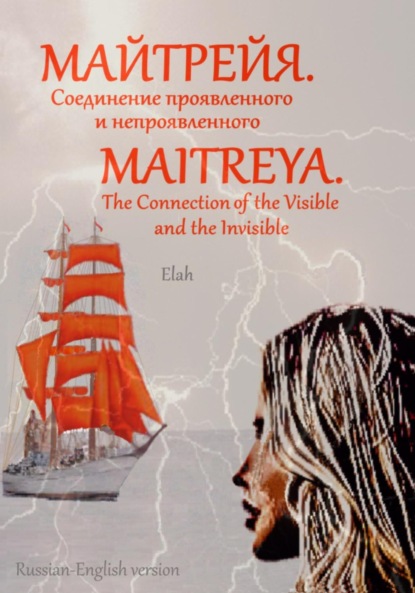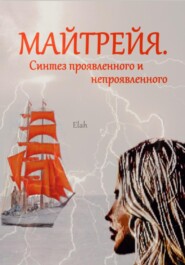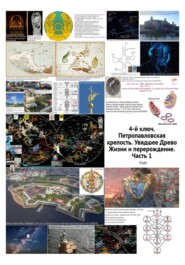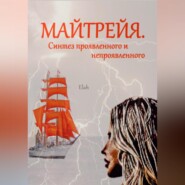По всем вопросам обращайтесь на: info@litportal.ru
(©) 2003-2024.
✖
Майтрейя. Слияние проявленного и непроявленного Maitreya. The Connection of the Visible and the Invisible
Настройки чтения
Размер шрифта
Высота строк
Поля
68
In linguistics, morphology is the study of words, how they are formed, and their relationship to other words in the same language. It analyzes the structure of words and parts of words, such as stems, root words, prefixes, and suffixes. Morphology also looks at parts of speech, intonation and stress, and the ways context can change a word's pronunciation and meaning. Morphology differs from morphological typology, which is the classification of languages based on their use of words and lexicology, which is the study of words and how they make up a language's vocabulary.
69
«В начале было Слово…» – первая строка Евангелия от Иоанна (Новый Завет), множество вариантов перевода и толкования которой дают разные уровни понимания смысла. ИсточникВикипедия.
70
John 1:1 is the first verse in the opening chapter of the Gospel of John. The traditional rendering in English is: In the beginning was the Word, and the Word was with God, and the Word was God. Source Wikipedia.
71
Майтрея (maitreya, «любящий, доброжелательный»; пали: Меттея; также Майтрейя, Майтри, Майдари) – у исповедующих буддизм монгольских и тюркских народностей самое почитаемое лицо, грядущий Учитель человечества, «Владыка, наречённый Состраданием». Буддисты верят, что Майтрея появится на Земле, достигнет полного просветления и будет учить чистой дхарме. Просветление (пробуждение) – религиозное понятие, означающее «целостное и полное осознание природы реальности». Дхарма, дхамма (dharma, dhamma) – одно из важнейших понятий в индийской философии и индийских религиях. Дхарму можно описать как совокупность установленных норм и правил, соблюдение которых необходимо для поддержания космического порядка. Источник Википедия.
72
According to Buddhist tradition, Maitreya is a bodhisattva who will appear on Earth in the future, achieve complete enlightenment, and teach the pure dharma.
The name Maitreya is derived from the Sanskrit word maitri"loving-kindness", which is in turn derived from the noun mitra "friend".
The English term enlightenment is the western translation of the term bodhi, "awakening", which was popularised in the Western world through the 19th century translations of Max M?ller. It has the western connotation of a sudden insight into a transcendental truth.
The term is also being used to translate several other Buddhist terms and concepts used to denote insight (prajna, kensho and satori); knowledge (vidhya); the "blowing out" (Nirvana) of disturbing emotions and desires and the subsequent freedom or release (vimutti); and the attainment of Buddhahood, as exemplified by Gautama Buddha.
Dharma is a key concept with multiple meanings in the Indian religions – Hinduism, Buddhism, Sikhism and Jainism. There is no single word translation for dharma in Western languages.
In Hinduism, dharma signifies behaviours that are considered to be in accord with Rta, the order that makes life and universe possible, and includes duties, rights, laws, conduct, virtues and ‘right way of living’. In Buddhism dharma means "cosmic law and order", but is also applied to the teachings of the Buddha. In Buddhist philosophy, dhamma/dharma is also the term for "phenomena". Dharma in Jainism refers to the teachings of tirthankara (Jina) and the body of doctrine pertaining to the purification and moral transformation of human beings. For Sikhs, the word dharm means the path of righteousness and proper religious practice.
In the Vedic religion, Rta (Sanskrit "that which is properly/excellently joined; order, rule; truth") is the principle of natural order which regulates and coordinates the operation of the universe and everything within it. Source Wikipedia.
73
Николай Константинович Рерих (27 сентября (9 октября) 1874 года, Санкт-Петербург – 13 декабря 1947 года, Наггар, Химачал-Прадеш, Индия) – русский художник, сценограф, философ-мистик, писатель, путешественник, археолог, общественный деятель. Академик Императорской (Российской) академии художеств (1909). В течение жизни создал около 7000 картин, многие из которых находятся в известных галереях мира, и около 30 томов литературных трудов, включая два поэтических. Автор идеи и инициатор Пакта Рериха, основатель международных культурных движений «Мир через культуру» и «Знамя Мира». Кавалер нескольких российских и иностранных наград.
Николай Рерих посвятил одну из серий своих картин Владыке Майтрее. В 1926 году во время завершения первого этапа Центрально-Азиатской экспедиции Николай Рерих прибыл в Москву, где и оставил эту серию. В настоящее время картина «Майтрейя Победитель» представлена в постоянной экспозиции Международного Центра-Музея им. Н. К. Рериха, шесть других полотен – в экспозиции Нижегородского художественного музея. Источник Википедия.
В октябре 1925 года Н. Рерих пишет в экспедиционном дневнике: «Задумана серия картин "Майтрейя"». И спустя месяц: «Серия "Майтрейя" сложилась из семи частей: 1. Шамбала идет. 2. Конь счастья. 3. Твердыня стен. 4. Знамя грядущего. 5. Мощь пещер. 6. Шепоты пустыни. 7. Майтрейя Победитель».
В 1925 г. в Хотане была написана и картина «Красные кони», примыкающая к серии «Майтрейя» по своему образно-стилистическому строю. Сюжетом для нее послужил старинный буддийский обряд, впервые увиденный путешественниками в Ладаке.
В ненастную погоду ламы поднимались на вершины гор и с молитвами «за неведомых, несказанных, неписанных» разбрасывали маленьких красных бумажных коней, которые во время полета должны были как бы «материализоваться» и оказать помощь попавшим в беду путникам. Источник сайт "Танаис галерея", посвященный русской живописи.
74
Nicholas Roerich (October 9, 1874 – December 13, 1947) – known also as Nikolai Konstantinovich Rerikh – was a Russian painter, writer, archaeologist, theosophist, perceived by some in Russia as an enlightener, philosopher, and public figure, who in his youth was influenced by a movement in Russian society around the spiritual. He earned several nominations for the Nobel Peace Prize long list.
Presently, the Nicholas Roerich Museum in New York City is a major institution for Roerich's artistic work. Numerous Roerich societies continue to promote his theosophical teachings worldwide. His paintings can be seen in several museums including the Roerich Department of the State Museum of Oriental Arts in Moscow; the Roerich Museum at the International Centre of the Roerichs in Moscow; the Russian State Museum in Saint Petersburg, Russia; a collection in the Tretyakov Gallery in Moscow; a collection in the Art Museum in Novosibirsk, Russia; an important collection in the National Gallery for Foreign Art in Sofia, Bulgaria; a collection in the Art Museum in Nizhny Novgorod Russia; National Museum of Serbia; the Roerich Hall Estate in Naggar, India; the Sree Chitra Art Gallery, Thiruvananthapuram, India; in various art museums in India; and a selection featuring several of his larger works in The Latvian National Museum of Art. Source Wikipedia.
Nicholas Roerich dedicated a series of his paintings the Lord Maitreya. In 1926, during the completion of the first phase of the Central Asian expedition of Nicholas Roerich arrived in Moscow, where he left the series. Currently the picture of "Maitreya Winner" is presented in the permanent exhibition of the International Center-Museum im. N. K. Rerikh, six other paintings in the exposition of the Nizhny Novgorod art Museum. Source Wikipedia (Russian version).
In October 1925, N. Roerich wrote in an expedition diary: "I conceived the series of paintings 'Maitreya.'" And a month later, he wrote: "a Series of "Maitreya" was formed from seven parts: 1. Shambhala goes. 2. Horse happiness. 3. The rock of the walls. 4. The banner of the future. 5. The power of the caves. 6. Whispers of the desert. 7. Maitreya Winner."
In 1925, in Khotan, he drew and painting "Red horse" that adjacent to a series of "Maitreya" in its imagery and stylistic formation. The idea for it was the ancient Buddhist ceremony that travelers discovered in Ladakh.
In inclement weather, Lama climbed to the top of the mountains, and saying prayers "for the unknown, the unspoken, unwritten," scattered small red paper horses that during the flight, like they had to "materialize" and to assist travelers in distress. Website source gallery "Tanais", dedicated to Russian painting (Russian version).
75
Петропавловский собор (официальное название – Собор во имя первоверховных апостолов Петра и Павла) – православный собор в Санкт-Петербурге в Петропавловской крепости, усыпальница русских императоров, памятник архитектуры петровского барокко. До 2012 г. собор высотой 122,5 м был самым высоким из зданий Санкт-Петербурга. Строительство храма началось 29 июня (10 июля) 1703 г. в день святых апостолов Петра и Павла (в XXI веке этот праздник отмечается 12 июля) на территории только что заложенной Петропавловской крепости. На колокольне в 1776 г. смонтированы куранты мастера Б. Оорта Краса из Голландии.
По своему плану и внешнему виду Петропавловский собор совершенно не похож на православные крестово-купольные или шатровые церкви. Храм представляет собой вытянутое с запада на восток прямоугольное здание «зального» типа, характерное именно для западноевропейской архитектуры. Главенствующая часть собора – многоярусная колокольня на западном фасаде, декорированная пилястрами.
Первые два яруса раздаются вширь и тем самым формируют плавный переход от основного здания собора к высокой башне. Третий ярус легко устремляется вверх, он увенчан золочёной восьмискатной крышей с четырьмя круглыми окнами в массивных белокаменных рамах. Над крышей располагается стройный и изящный восьмигранный барабан с узкими вертикальными проёмами. Над ним – высокая, тоже восьмигранная, золотая корона, а на ней вместо традиционного креста – тонкая золотая башенка, служащая основанием 40-метрового шпиля. На самом верху установлена фигура ангела с крестом в руках (высота креста около 6,5 метров). Высота фигуры – 3,2 метра, размах крыльев – 3,8 метра, а масса – около 250 кг. Источник Википедия.
Его выкрашенный золотом шпиль достигает высоты 123 метров (404 фута), а на его вершине изображен ангел, держащий крест. Этот ангел – один из самых важных символов Санкт-Петербурга.
Когда царь Петр Великий посетил Нидерланды в 1698 году, он услышал идеально настроенные карильоны Гемони в Амстердаме и Лейдене, поющие все 24 часа в сутки, автоматически каждые четверть часа. Позже, в 1717 году, он посетил Фландрию инкогнито и поднялся на башню собора Богоматери в Антверпене, где, должно быть, услышал один из двух гемониевых карильонов в одной из башен этого собора. На него произвело впечатление звучание карильона, и он захотел такой же для своего нового собора в Санкт-Петербурге. Поэтому он заказал его в 1720 году в Нидерландах. … В 1756 году башня сгорела дотла после грозы. …
Нынешний Петропавловский карильон – подарок Санкт-Петербургу от правительства Фландрии и более чем 350 спонсоров из разных стран. Взнос был представлен от имени Ее Величества королевы Бельгии Фабиолы, Бельгийского фонда короля Будевейна, правительства провинции Фландрия, властей различных фламандских городов и сообществ, включая предприятия и финансовые учреждения, культурные сообщества, школы и университеты, а также простых граждан Бельгии, России и других стран., Англия, Германия, Литва, Нидерланды, Новая Зеландия, Португалия, США и Япония.
ИсточникВикипедия (английскийвариант).
76
The Peter and Paul Cathedral is a Russian Orthodox cathedral located inside the Peter and Paul Fortress in St. Petersburg, Russia. It is the first and oldest landmark in St. Petersburg, built between 1712 and 1733 on Zayachy (Hare) Island along the Neva River. Both the cathedral and the fortress were originally built under Peter the Great and designed by Domenico Trezzini. The cathedral's bell tower is the world's tallest Orthodox bell tower. Since the belfry is not standalone, but an integral part of the main building, the cathedral is sometimes considered the highest Orthodox Church in the world.
The current building, the first stone church in St. Petersburg, was designed by Trezzini and built between 1712 and 1733. Its gold-painted spire reaches a height of 123 metres (404 ft) and features at its top an angel holding a cross. This angel is one of the most important symbols of St. Petersburg.
The cathedral was closed in 1919 and turned into a museum in 1924. It is still officially a museum; religious services, however, resumed in 2000.
When Tsar Peter the Great visited the Netherlands in 1698, he heard the perfect tuned Hemony carillons in Amsterdam and Leiden singing all 24 hours of the day, every quarter of an hour automatically. Later in 1717 he visited Flanders incognito and climbed the tower of the Cathedral of Our Lady in Antwerp, where he must have heard one of the two Hemony carillons in one of the towers of this cathedral. He was impressed by the sound of a carillon and wanted one like these for his new cathedral in St. Petersburg. So he ordered it in 1720 from the Netherlands. In Amsterdam the only bellfounder in that time was Jan Albert de Grave. He was married to the widow of Claude Fremy. This Claude Fremy was a pupil of Hemony. So Jan Albert de Grave was presumably the bellfounder who made these bells. Some years later he also made a carillon for Potsdam. The people in St. Petersburg could only listen to this well-tuned instrument for a short time. In 1756 the tower burned down after a thunderstorm. …
The current Peter and Paul carillon is a gift to St. Petersburg from the Government of Flanders, and more than 350 sponsors from different countries. The contribution was presented in the name of Her Majesty Queen Fabiola of Belgium, the Belgian King Boudewijn Fund, the Government of the Province of Flanders, the authorities of various Flemish cities and communities, including businesses, and financial institutions, cultural communities, schools and universities, and also ordinary citizens of Belgium, Russia, England, Germany, Lithuania, the Netherlands, New Zealand, Portugal, the USA and Japan. Source Wikipedia.
The first two tiers are distributed in breadth and thus form a smooth transition from the main building of the cathedral to the high tower. The third tier easily rushes up, it is crowned with a gilded octagonal roof with four round windows in massive white stone frames. Above the roof is a slender and elegant octagonal drum with narrow vertical openings. Above it is a high, also octagonal, golden crown, and on it, instead of the traditional cross, there is a thin golden turret that serves as the base of a 40–meter spire. At the very top there is a figure of an angel with a cross in his hands (the height of the cross is about 6.5 meters). The height of the figure is 3.2 meters, the wingspan is 3.8 meters, and the weight is about 250 kg. Source Wikipedia (Russian version)
77
Петропавловская крепость – крепость в Санкт-Петербурге, расположенная на Заячьем острове, историческое ядро города. Официальное название – Санкт-Петербургская, в 1914—1917 годах – Петроградская крепость. Крепость была заложена 16 (27) мая 1703 года по совместному плану Петра I и французского инженера Ламбера: 6 бастионов, соединённых куртинами, 2 равелина, кронверк (первоначально дерево-земляные, в 1730-е-1740-е и 1780-е годы одеты камнем). Петропавловская крепость никогда не принимала непосредственного участия в военных действиях. С самого начала своего существования она стала использоваться в качестве главной политической тюрьмы России. Источник Википедия.
Построенный в разгар Северной войны для защиты предполагаемой столицы от опасной шведской контратаки, форт так и не выполнил своего военного назначения. В течение года цитадель была достроена шестью бастионами из земли и дерева, а с 1706 по 1740 год она была перестроена из камня. Примерно с 1720 года форт служил базой для городского гарнизона, а также тюрьмой для высокопоставленных или политических заключенных. Трубецкой бастион, перестроенный в 1870-х годах, стал главным тюремным блоком. Источник Википедия (английский вариант).
78
The Peter and Paul Fortress (Russian: Петропа?вловская кре?пость, Petropavlovskaya Krepost) is the original citadel of St. Petersburg, Russia, founded by Peter the Great in 1703 and built to Domenico Trezzini's designs from 1706 to 1740. Built at the height of the Northern War in order to protect the projected capital from a feared Swedish counterattack, the fort never fulfilled its martial purpose. The citadel was completed with six bastions in earth and timber within a year, and it was rebuilt in stone from 1706 to 1740. From around 1720, the fort served as a base for the city garrison and also as a prison for high-ranking or political prisoners. The Trubetskoy Bastion, rebuilt in the 1870s, became the main prison block.
The fortress contains several notable buildings clustered around the Peter and Paul Cathedral (1712–1733), which has a 122.5 m (402 ft) bell-tower (the tallest in the city centre) and a gilded angel-topped cupola.








